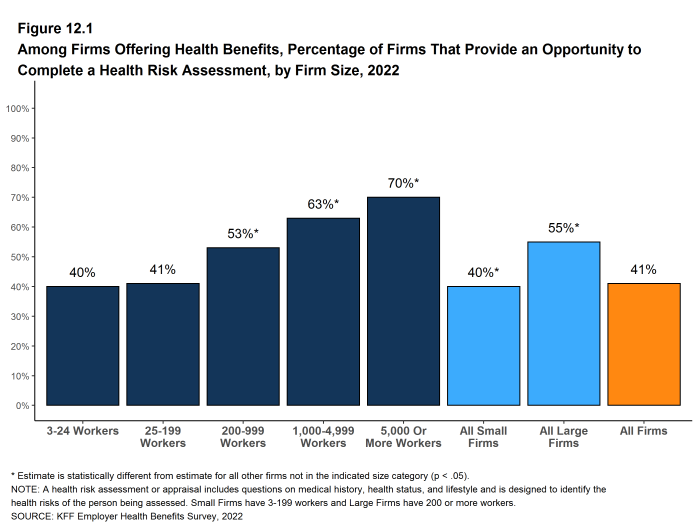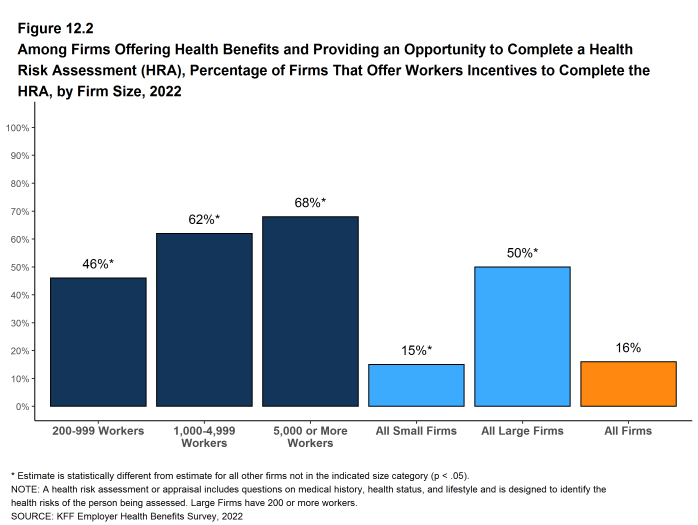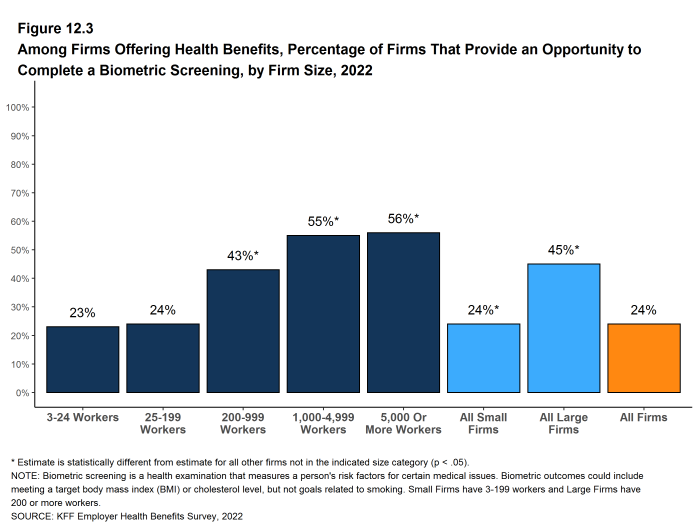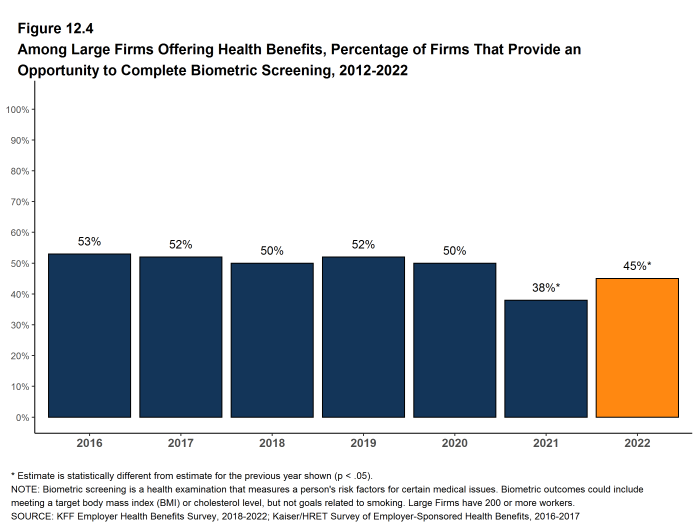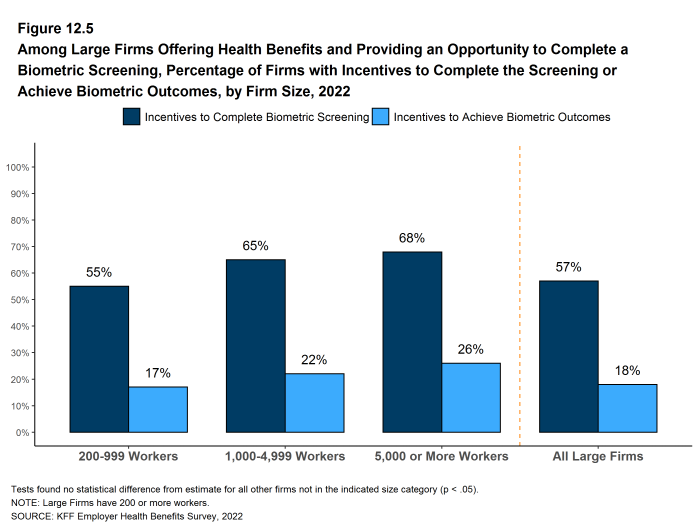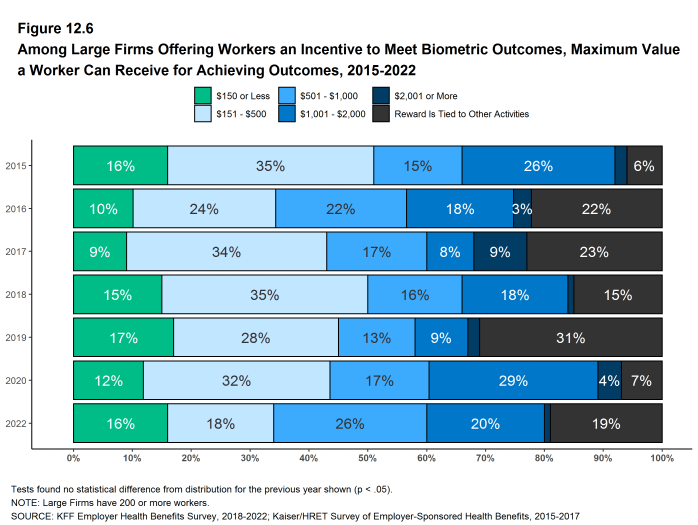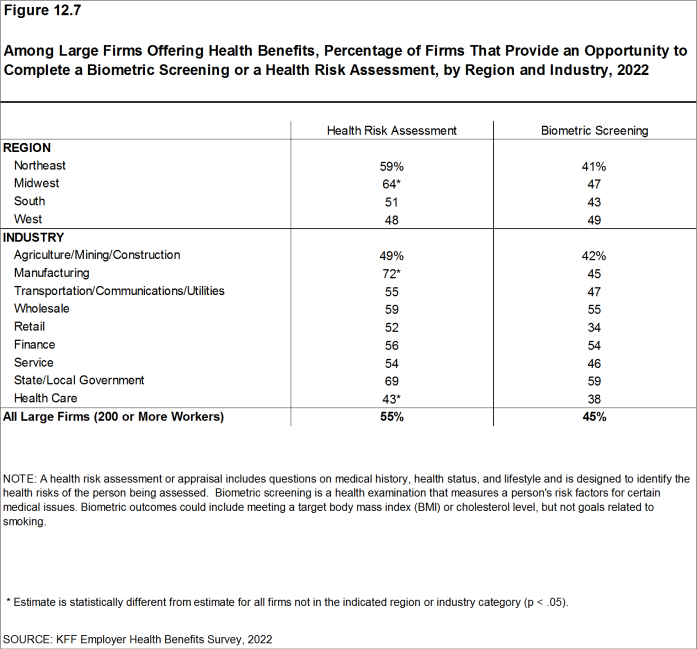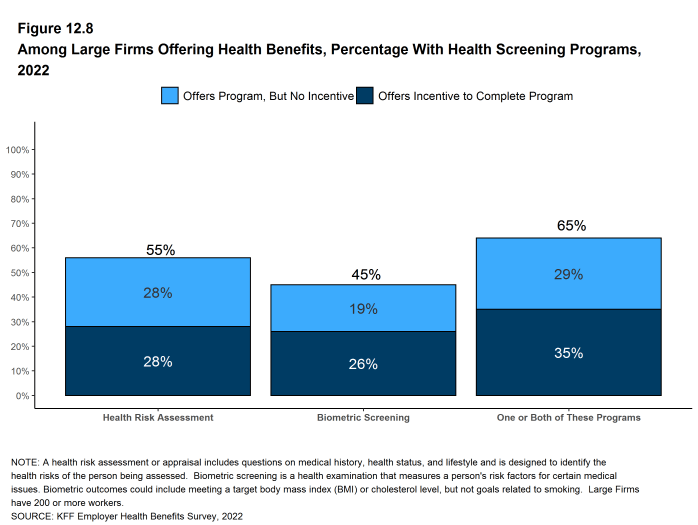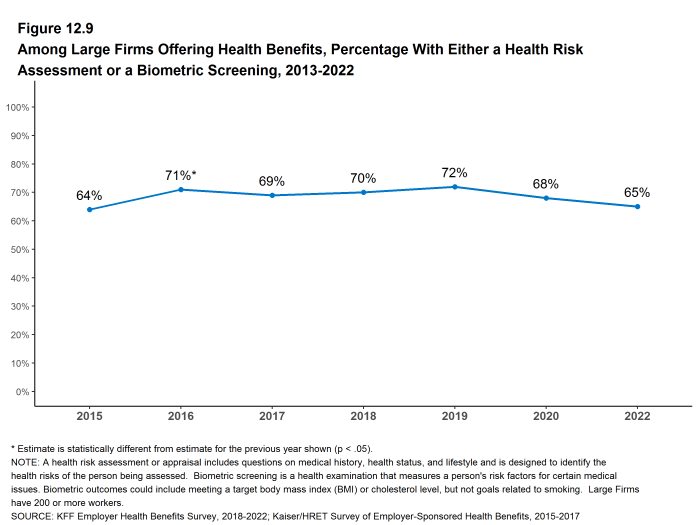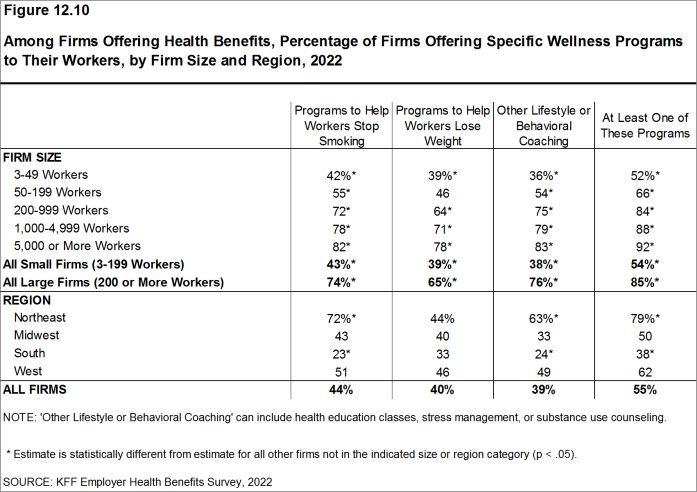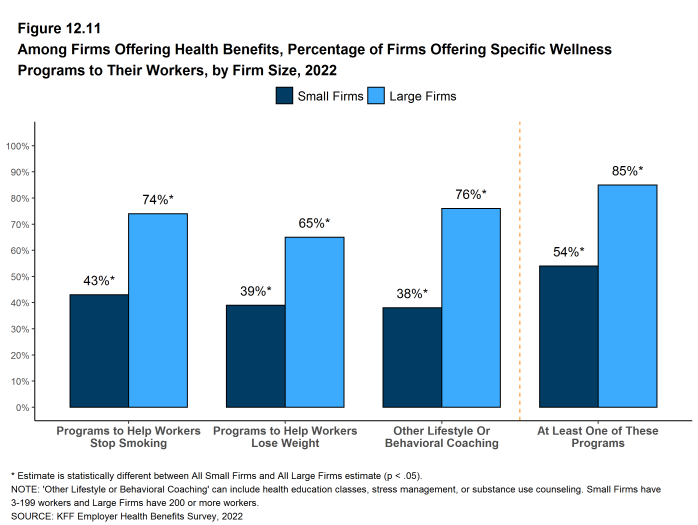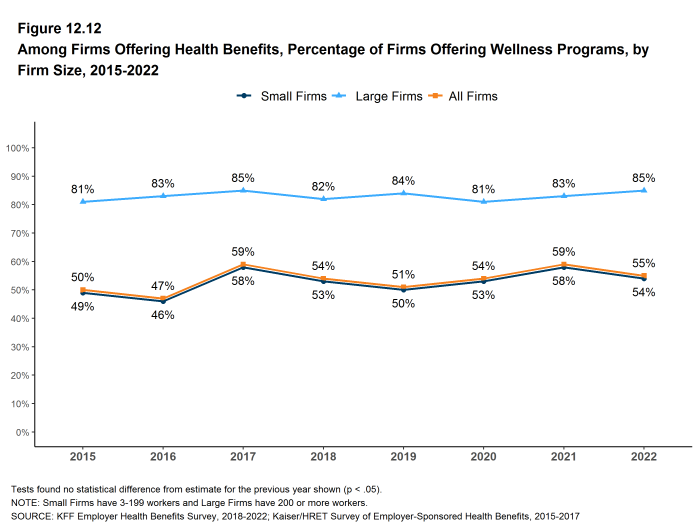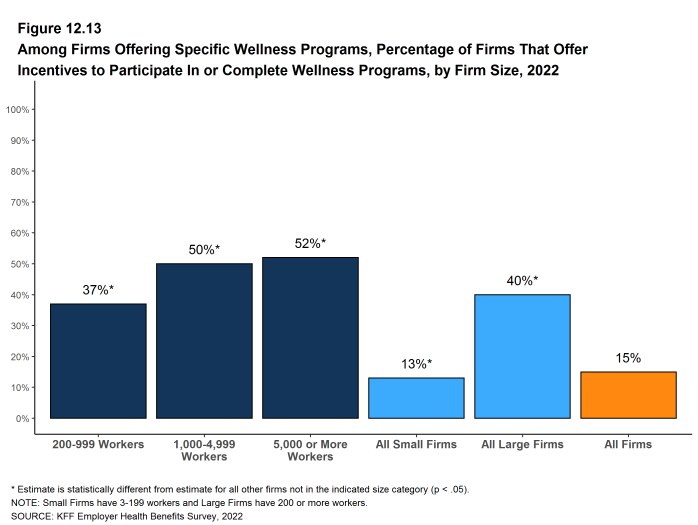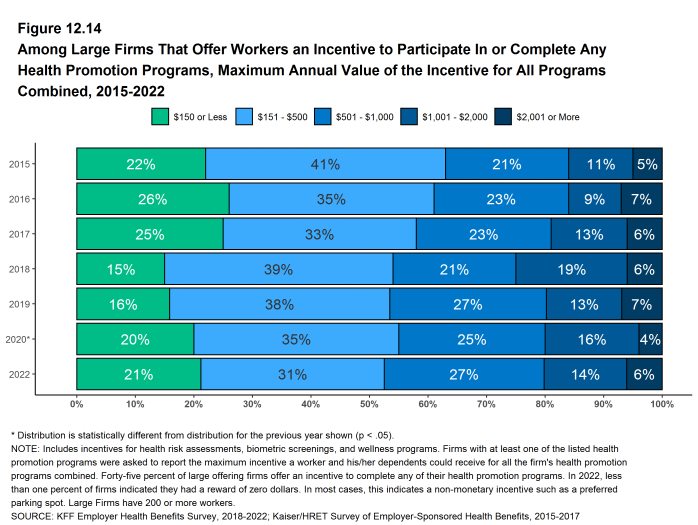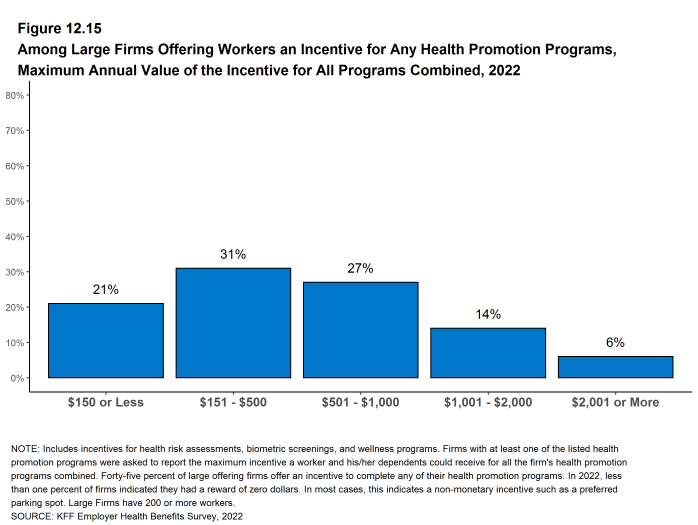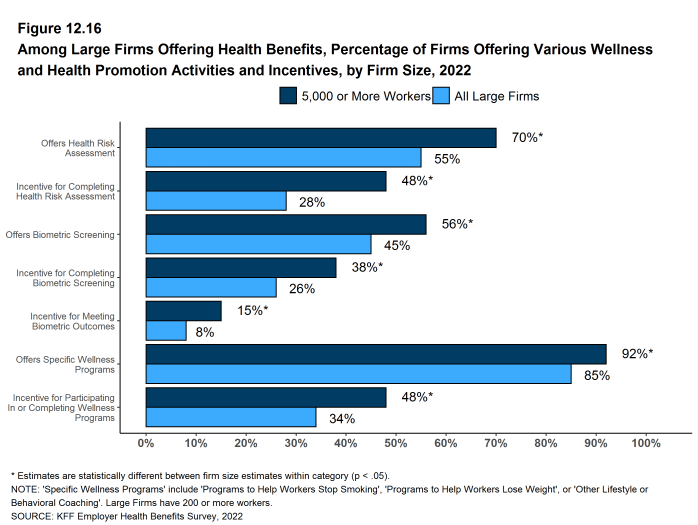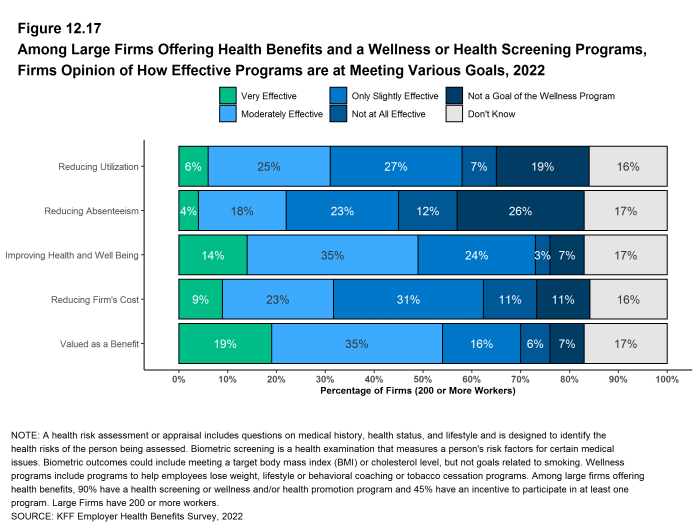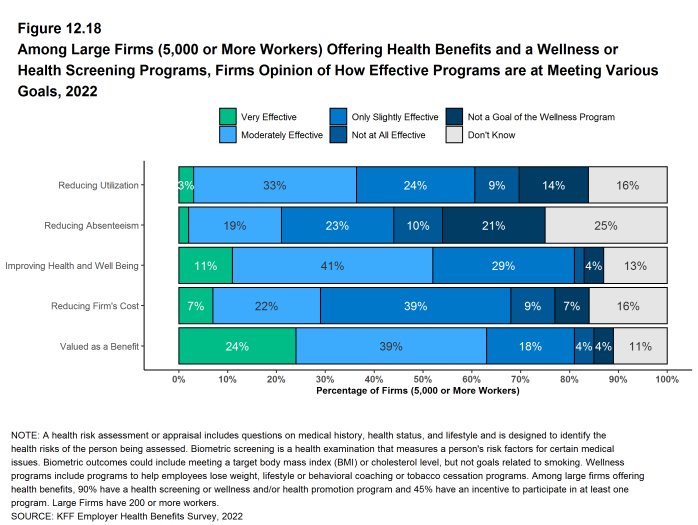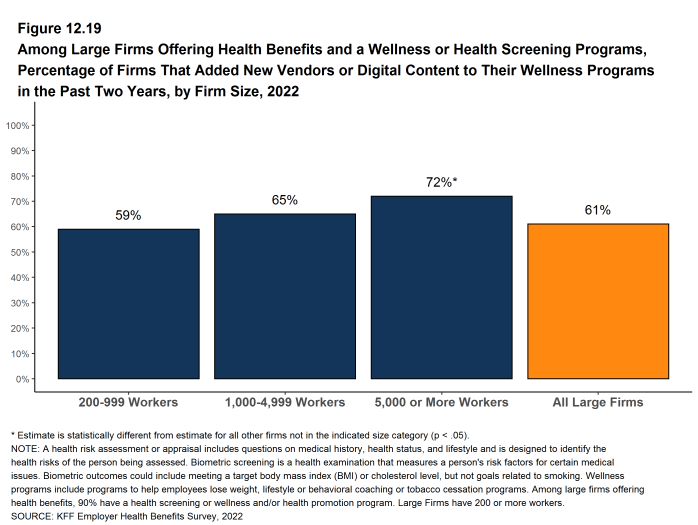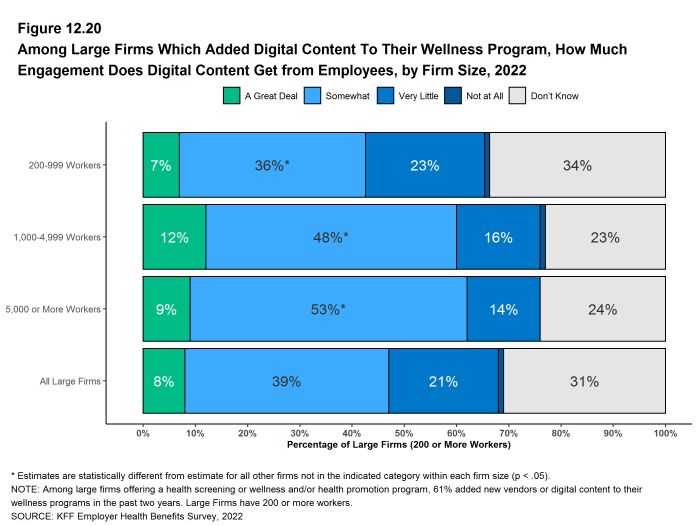2022 Employer Health Benefits Survey
Section 12: Health Screening and Health Promotion and Wellness Programs
Most firms offer some form of wellness program to help workers and family members identify health issues and manage chronic conditions. Some employers believe that improving the health of their workers and their family members can improve wellbeing and productivity, as well as reduce health care spending
In addition to offering wellness programs, a majority of large firms now offer health screening programs, including health risk assessments, which are questionnaires asking workers about lifestyle, stress, or physical health, and biometric screening, which we define as in-person health examinations conducted by a medical professional. Firms and insurers may use the health information collected during screenings to target wellness offerings or other health services to workers with certain conditions or behaviors. Some firms have incentive programs that reward or penalize workers for different activities, including participating in wellness programs or completing health screenings.
Among large firms offering health benefits in 2022, 55% offer workers the opportunity to complete a health risk assessment, 45% offer workers the opportunity to complete a biometric screening, and 85% offer workers one or more wellness programs, such as programs to help them stop smoking or lose weight, or programs that offer lifestyle and behavioral coaching. Substantial shares of these large firms provide incentives for workers to participate in or complete the programs.
Only firms offering health benefits were asked about their wellness and health promotion programs.
Due to the COVID-19 pandemic, we changed the focus of our questions in 2021 to look at how employers were modifying their health screening and health promotions in response to the COVID-19, in particular to address the large share of the workforce that was working remotely. For the 2022 survey we have reverted to our normal questions about these programs. Due to this break in continuity and because we know that some employers made changes to their screening and wellness programs as the pandemic intensified, we make comparisons to pre-pandemic findings from 2019.
HEALTH RISK ASSESSMENTS
Many firms provide workers the opportunity to complete a health risk assessment to identify potential health issues. Health risk assessments generally include questions about medical history, health status, and lifestyle. At small firms, health risk assessments are often administered by an insurer.
- Among firms offering health benefits, 40% of small firms and 55% of large firms provide workers the opportunity to complete a health risk assessment [Figure 12.1]. The percentage of large firms with a health risk assessment program is lower than the percentage in 2019 (65%).
- Some firms offer incentives to encourage workers to complete a health risk assessment.
- Among large firms that offer a health risk assessment, 50% use incentives or penalties to encourage workers to complete the assessment, the same as the percentage (50%) in 2019 [Figure 12.2].
Figure 12.1: Among Firms Offering Health Benefits, Percentage of Firms That Provide an Opportunity to Complete a Health Risk Assessment, by Firm Size, 2022
BIOMETRIC SCREENING
Biometric screening is a health examination that measures a person’s risk factors (such as cholesterol, blood pressure, and body mass index (BMI)) for certain medical issues. A biometric outcome involves assessing whether the person meets specified health targets related to certain risk factors, such as meeting a target BMI or cholesterol level. As defined by this survey, goals related to smoking are not included in the biometric screening questions.
The share of firms with biometric screening fell during 2021, likely due to COVID-19-related disruptions at workplaces, such as employees working remotely and reduced access at on-site health clinics.
- Among firms offering health benefits, 24% of small firms and 45% of large firms provide workers the opportunity to complete a biometric screening [Figure 12.3]. The percentage of large firms with a biometric screening program is higher than the percentage in 2021 (38%). This suggests that some large employers are reinstating or revamping programs that were discontinued or suspended during the pandemic [Figure 12.4].
- Some firms with biometric screening programs offer incentives to encourage workers to complete a biometric screening.
Among large firms with a biometric screening program, 57% use incentives or penalties to encourage workers to complete the assessment, similar to the percentage (58%) in 2019 [Figure 12.5].
- In addition to incentives for completing a biometric screening, some firms offer workers incentives to meet biometric outcomes, such as maintaining a certain cholesterol level or body weight. Among large firms with a biometric screening program, 18% have incentives or penalties tied to whether workers meet or achieve specified biometric outcomes, similar to the percentage (14%) in 2019 [Figure 12.5].
- The size of the incentives firms offer for meeting biometric outcomes varies considerably. Among large firms offering a reward or penalty for meeting biometric outcomes, the maximum reward is valued at $150 or less for 16% of firms and more than $1,000 for 21% of firms [Figure 12.6]. Nineteen percent of these firms combine the reward with incentives for other activities. This may include employers who ask employees to complete several health screening, disease management, wellness/health promotion activities in order to qualify for incentives.
Figure 12.3: Among Firms Offering Health Benefits, Percentage of Firms That Provide an Opportunity to Complete a Biometric Screening, by Firm Size, 2022
Figure 12.4: Among Large Firms Offering Health Benefits, Percentage of Firms That Provide an Opportunity to Complete Biometric Screening, 2012-2022
Figure 12.5: Among Large Firms Offering Health Benefits and Providing an Opportunity to Complete a Biometric Screening, Percentage of Firms With Incentives to Complete the Screening or Achieve Biometric Outcomes, by Firm Size, 2022
Figure 12.6: Among Large Firms Offering Workers an Incentive to Meet Biometric Outcomes, Maximum Value a Worker Can Receive for Achieving Outcomes, 2015-2022
HEALTH SCREENING PROGRAMS
Among firms offering health benefits, 48% of small firms and 65% of large firms offer workers a health risk assessment, biometric screening or both screening programs [Figure 12.8].
Figure 12.8: Among Large Firms Offering Health Benefits, Percentage With Health Screening Programs, 2022
Figure 12.9: Among Large Firms Offering Health Benefits, Percentage With Either a Health Risk Assessment or a Biometric Screening, 2013-2022
WELLNESS AND HEALTH PROMOTION PROGRAMS
Large shares of employers continue to offer educational and other programs to help workers engage in healthy lifestyles and reduce health risks. Wellness and health promotion programs may include exercise programs, health education classes, health coaching, and stress-management counseling. These programs may be offered directly by the firm, an insurer, or a third-party contractor.
- Among firms offering health benefits, 43% of small firms and 74% of large firms offer programs to help workers stop smoking or using tobacco, 39% of small firms and 65% of large firms offer programs to help workers lose weight, and 38% of small firms and 76% of large firms offer some other lifestyle or behavioral coaching program. Overall, 54% of small firms and 85% of large firms offering health benefits offer at least one of these three programs [Figure 12.11] and [Figure 12.12].
- Forty percent of large firms offering one of these wellness or health promotion programs offer an incentive to encourage workers to participate in or complete the programs [Figure 12.13]
Figure 12.11: Among Firms Offering Health Benefits, Percentage of Firms Offering Specific Wellness Programs to Their Workers, by Firm Size, 2022
Figure 12.12: Among Firms Offering Health Benefits, Percentage of Firms Offering Wellness Programs, by Firm Size, 2015-2022
INCENTIVES FOR WELLNESS AND HEALTH SCREENING PROGRAMS
Firms with incentives for health risk assessments, biometric screenings, or wellness or health promotion programs were asked to report the maximum reward or penalty a worker could earn for all of the firm’s health promotion activities combined. Some firms do not offer incentives for individual activities, but offer rewards to workers who complete a variety of activities.22 Among large firms offering incentives for any of these programs, the maximum value for all wellness-related incentives is $150 or less in 21% of firms and more than $1,000 in 20% of firms [Figure 12.15].
Figure 12.14: Among Large Firms That Offer Workers an Incentive to Participate in or Complete Any Health Promotion Programs, Maximum Annual Value of the Incentive for All Programs Combined, 2015-2022
Figure 12.15: Among Large Firms Offering Workers an Incentive for Any Health Promotion Programs, Maximum Annual Value of the Incentive for All Programs Combined, 2022
EFFECTIVENESS OF WELLNESS AND HEALTH SCREENING PROGRAMS
Large firms (200 or more workers) offering one or more health promotion or health screening programs were asked whether they believed the programs were effective in meeting certain objectives often offered as reasons to have these programs. Firms offering these programs may have different objectives for different programs, so we offered respondents the opportunity to say that a specific objective was not a goal of their programs.
Among large firms offering one or more of these programs:
- Reducing the firm’s health care costs – Only 9% said that their programs were “very effective” at reducing health care costs, 23% said that they were “moderately effective”, 42% said that they were “only slightly effective” or “not at all effective”, 11% said that reducing health care costs is not an objective of their programs, and 16% did not know [Figure 12.17].
- Reducing health care utilization – Only 6% said that their programs were “very effective” at reducing the use of health care, 25% said that they were “moderately effective”, 34% said that they were “only slightly effective” or “not at all effective”, 19% said that reducing health care use is not an objective of their programs, and 16% did not know [Figure 12.17].
- Reducing employee absenteeism – Only 4% said that their programs were “very effective” at reducing absenteeism by employees, 18% said that they were “moderately effective”, 36% said that they were “only slightly effective” or “not at all effective”, 26% said that reducing employee absenteeism is not an objective of their programs, and 17% did not know [Figure 12.17].
- Improving the health and well being of enrollees – Fourteen percent said that their programs were “very effective” at improving the health and well being of enrollees, 35% said that they were “moderately effective”, 27% said that they were “only slightly effective” or “not at all effective”, 7% said that improving the health and well being is not an objective of their programs, and 17% did not know [Figure 12.17].
- Being valued as a benefit by employees – Nineteen percent said that their programs were “very effective” at being valued as a benefit by their employees, 35% said that they were “moderately effective”, 22% said that they were “only slightly effective” or “not at all effective”, 7% said that being valued as a benefit is not an objective of their programs, and 17% did not know [Figure 12.17].
Figure 12.17: Among Large Firms Offering Health Benefits and a Wellness or Health Screening Programs, Firms Opinion of How Effective Programs Are at Meeting Various Goals, 2022
DIGITAL CONTENT FOR WELLNESS PROGRAMS
Sixty-one percent of large firms with a wellness program, including 72% of those with 5,000 or more employees, have added digital content to one or more of their wellness programs in the last two years [Figure 12.19].
- Among large firms that added digital content to a wellness program, 8% say that employees have engaged “a great deal” with the digital content, 39% say that employees have engaged “somewhat,” 22% say that employees have engaged “very little” or “not at all,” and 31% do not know [Figure 12.20].
Figure 12.19: Among Large Firms Offering Health Benefits and a Wellness or Health Screening Programs, Percentage of Firms That Added New Vendors or Digital Content to Their Wellness Programs in the Past Two Years, by Firm Size, 2022
- In 2022, less than one percent of firms indicated that they had an incentive for completing health risk assessments, biometric screenings, or wellness or health promotion programs, but had a maximum incentive of zero dollars. These firms may have non-monetary incentives such as preferred parking spots or employee recognition programs.↩︎

